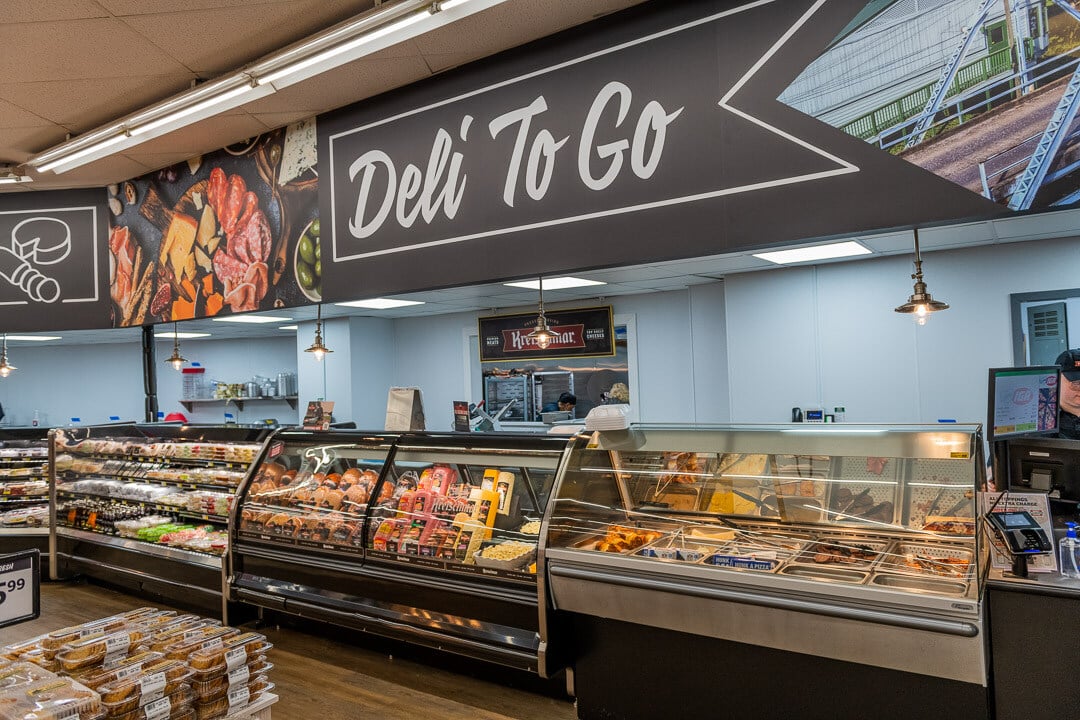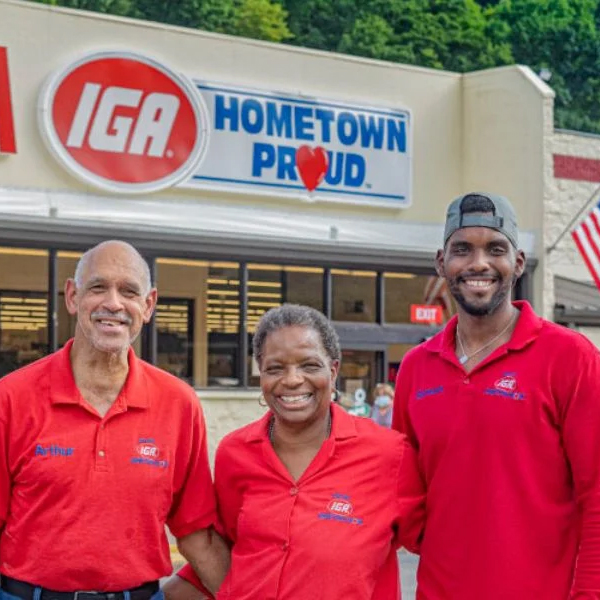Isom IGA
After disastrous flood wiped out their store, Isom Iga rebuilt using green strategies to better serve their community and their operations.
Isom IGA installed energy star appliances, led lighting, and solar panels to cut their energy usage by 30% and became a beacon of hope for their town.

01 / The Initiative
Company Name: Isom IGA
Company Description: Isom IGA is a full-service rural retail grocer that’s been a community cornerstone for over two decades. Deeply embedded in the fabric of Kentucky’s Letcher County, the store is both a place to shop and a gathering space for locals.
Build Back Better... And Green
In 2022, a flood devastated Isom IGA, submerging the 15,000-square-foot store under 8.5 feet of water and destroying all of its equipment. Operating in one of Kentucky’s most economically disadvantaged counties, owners Gwen and Simon Christon faced a difficult decision: rebuild the same way, or rebuild better. With electricity rates soaring and residents relying heavily on fixed incomes and SNAP benefits, Isom IGA needed a sustainable model to remain affordable and competitive.




02 / Goals
Revive a beloved community grocery store with green innovation, community spirit, and sustainable small business that will survive any storm.
Turning Tragedy into Transformation
Isom IGA used the opportunity from rebuilding to create a store that would thrive for decades. Simon prioritized energy efficiency and long-term affordability, aiming to lower costs and reinvest savings into jobs, infrastructure, and customer pricing.
The Road to Sustainability
Gwen and Simon rebuilt their grocery store to not only serve the key food, goods and supplies for their neighbors, but be a hub for the community. Their primary objectives were:
Installed rooftop solar to offset high electricity costs
Replaced outdated open-air coolers with closed-door, Energy Star-certified models
Applied for USDA equipment grants to subsidize high-efficiency upgrades
Collaborated with a nonprofit for technical guidance, paperwork, and data analysis
Modernized store layout for improved operations and customer experience
03 / The Strategy
Implementation Tip 1:
New Energy Star appliances reduce energy consumption and maintenance costs.
Implementation Tip 2:
Search for grants, rebates, tax incentives at your local public utility, town/city, and state to implement a lower or no cost solution for you.
Energy Saved. Efficiency Gained.
Understanding the need to build back smarter, Isom IGA—started with sustainability. By upgrading to Energy Star appliances, they not only cut down on energy use but also saw a drop in maintenance costs. Once more, they tapped into local and state resources—grants, rebates, and tax incentives—that helped make the transition affordable.
Their story proves that going green isn’t just good for the planet; it’s a practical path forward for small businesses looking to rebuild, reduce costs, and future-proof their operations.

Strategize Savings With Solar

04 / Challenges
Implementation Tip 3:
Solar energy combined with energy star compliance can yield multiplied savings.
Making Change in a Traditional Marketplace
Simon Christon of Isom IGA, a family-owned grocery store in rural Kentucky, faced tough decisions on the path to sustainability. For Simon, going green wasn’t about riding a trend—it was about doing what was right for his community and the environment. But that didn’t make the journey easy.
Breakthrough: Persistence and Practicality
Rather than going all-in at once, Simon took a phased, strategic approach. He started with manageable upgrades, like replacing lighting and adjusting energy usage habits. Over time, he worked with local utilities and nonprofits to secure grants, plan upgrades, and install solar panels. Communication was key—he kept staff and customers informed about changes and why they mattered.
Simon’s advice? “Start where you can. Don’t let perfection be the enemy of progress.” By breaking down sustainability into smaller, achievable steps, he turned big goals into daily practice—one that helped the environment without breaking the bank.
05 / Results
Big Stat 1: $4,000–$5,000/month saved on electricity by switching to solar and energy-efficient appliances
Big Stat 2: 33 employees hired, up from 25 pre-flood—expanding local job opportunities
Sustainability Showed It's Benefits
Isom IGA reopened and became a symbol of strength and sustainability in Eastern Kentucky. The changes reduced energy costs, created jobs, and sparked community pride.
Additional Impacts:
• Lowered maintenance costs with new equipment
• Improved customer experience and loyalty
• Increased traffic from neighboring towns
• Recognized as a regional model for small-town green retail

Sustainability For The Win!

Proving Sustainability is Smart Business
Isom IGA’s experience shows that investing in sustainability isn’t just good for the planet—it’s good for business. By focusing on energy efficiency and modernizing equipment, Simon Christon has not only reduced operating costs but also revitalized the customer experience. The store has become a hub of community pride and a blueprint for small-town resilience.
Things Look Brighter with a Solar Future
Simon isn’t stopping here. He’s currently applying for grants to expand the store’s solar coverage to the remaining half of the roof and is planning to install a new energy-efficient hot water system that repurposes excess heat from store equipment.
He’s also thinking long term. “We’re set up well now, but in 10 to 12 years, we’ll be ready to reinvest in equipment upgrades,” Simon shared. With his forward-thinking mindset, Simon is positioning Isom IGA to stay competitive, energy-efficient, and community-centered for decades to come.
Related Case Studies

May 7, 2025
Isom IGA
After disastrous flood wiped out their store, Isom Iga rebuilt using green strategies to better serve their community and their operations.
Isom IGA installed energy star appliances, led lighting, and solar panels to cut their energy usage by 30% and became a beacon of hope for their town.





